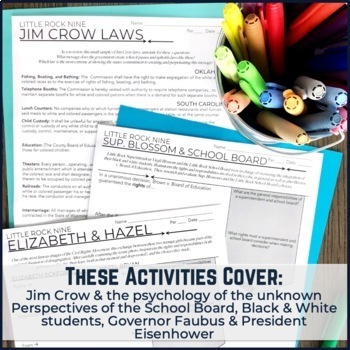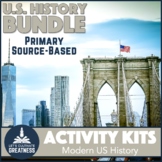Little Rock Nine Activity Kit Print & Digital
- Zip
- Google Apps™

What educators are saying
Also included in
- Step up your 1900s U.S. History units (Great Depression, WWII, & Civil Rights Movements) with these 6 kits, high-interest deep-dives that will intrigue your students with the backstories and primary sources that make studying history so fascinating. Each kit comes in both printable PDF and digiPrice $23.20Original Price $29.00Save $5.80
Description
Tap into your students’ personal fears, decision-making skills, and creativity in these 6 activities that cover the actions and people, from President Eisenhower and Governor Faubus to the 9 Little Rock Central High School students themselves, that turned the first day of the school year into a crisis.
- What made Little Rock, Arkansas 1957 the collision of emotions and laws, of rights and responsibilities?
- Why did that photo of Hazel Bryan and Elizabeth Eckford capture the attention of the entire nation?
- What does this mean to your students now?
This activity kit offers thought-provoking primary source-based activities that build towards students exploring the role that fear and impulses have on our decision-making, especially in regards to our rights and responsibilities as Americans.
This resource comes in both PDF and Google Slides for your flexibility!
**************************************
Greatness is recognizing one’s fears and not letting it stand in the way of one’s responsibilities.
Challenge your students to investigate why one school district’s handling of the Brown v. Board ruling turned into a national collision of rights and responsibilities and culminate their learning with a meaningful, personalized project.
Use as many or few activities you want; these are fairly interchangeable to match the classroom time you have!
Cut through the boring textbook and head straight to the compelling sources and deep-down emotions in this assign-and-go activity pack that makes learning real and immediately relevant. In just a handful of classes, your students will be empowered in no longer wondering, “How can I take control of my fears in order to make a better decision in the future?”
Included in this complete resource:
Teacher Materials
- Teacher Overview and detailed Lesson Plans for each activity
- Answer keys and rubrics
- Links to high-quality outside sources to guide student research
- Annotating a Text skill sheet mini-lesson
Student Materials
- Concept Definition notes to develop a nuanced understanding of the "right" and "responsibility"
- Contextual Background Activities on Jim Crow laws and an intriguing TED Talk on fear
- Primary Source Analysis Activities to examine the various stakeholders' rights and responsibilities as well as to evaluate the choices they made, like those of the Little Rock School Board, President Eisenhower, Governor Faubus, Elizabeth Eckford, and Hazel Bryan
**************************************
Want more Civil Rights Movement?
Civil Rights Movement Primary Source 6-Pack: explore the arguments made to convince the nation to finish the unfinished work of equality
Want more engaging U.S. History activity packs?
Great Depression: empathize with Dust Bowl survivors in 7 activities that analyze photos and personal letters.
WWII Japanese Internment: empathize with Japanese Americans in 6 activities to analyze photos in order to create their own image.
Roosevelts & Rockwell's Four Freedoms: dig deeper into the call to action against the growing atrocities overseas in order to connect art to real event.
WWII Propaganda Posters: learn the techniques of persuasion in 6 activities in order to create own poster.
Montgomery Bus Boycott: discover the untold story behind the event that started the Civil Rights Movement and challenge students to start their own movement.
This listing is for one license for regular classroom use by a single teacher only. In upholding copyright law, PDF resources are uneditable and resources made for Google Classroom are limitedly editable, unless otherwise stated. By purchasing a license to this resource, you have access to all future updates at no cost, available under “My Purchases". Multiple and transferable licenses are available for purchase. To request a complete terms of use prior to purchase or if you have any questions about this resource, please leave a question below under Product Q&A.






